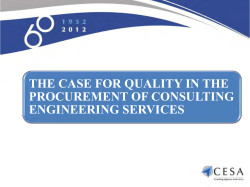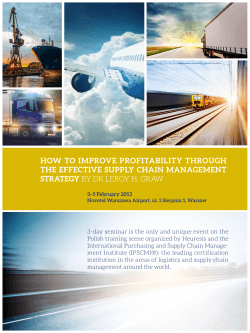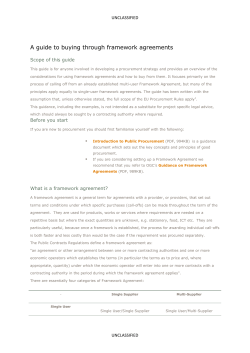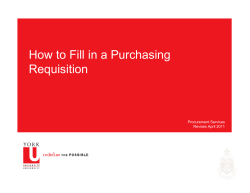
The 2011 International Procurement Yearbook Section 1
CONTENTS The 2011 International Procurement Yearbook 3RD ANNUAL EDITION • • • • • • • • • • • • • I N T E R N AT I O N A L I N C . VI VII PREFACE ABOUT THE FIRM 01 Section 1 SAMPLE SAMPLE SAMPLE SAMPLE GENERAL - GLOBAL CONSTRUCTION PROCUREMENT TOPICS PURCHASE ORDERS & CONTRACTS PURCHASING / PROCUREMENT AND CONTRACTING METHODS VARIOUS EORMS OF CONSTRUCTION CONTRACTS INVITATION TO BID / INSTRUCTIONS TO BIDDERS / BID PACKAGE DOCUMENTATION CONTRACT ADMINISTRATION ORGANIZATIONAL ISSUES / PRROCUREMENT ROLES AND RESPONSIBILITIES QUALITY CONTROL (QC/QA), SAFETY, INSPECTION, EXPEDITING AND TRANSPORTATION ACTIVITIES INTERNATIONAL PROCURMENT ISSUES SAMPLES OF INTERNATIONAL AND USA CONSTRUCTION / CONSULTING CONTRACTS COUNTRY PROCUREMENT: DATA ON 125 COUNTRIES GLOSSARY OF INTERNATIONAL PROCUREMENT TERMS PROCUREMENT FORMS GLOBAL CONSTRUCTION PROCUREMENT TOPICS Trends and issues we will see in 2011 and beyond Procurement / Project Delivery Methods and Issues Recent History and the influence of World Events on Engineering and Construction Costs in the last couple of decades Project Execution Conventional approach: / Concurrent / Overlapping approach / Fast track approach Various Types of Construction Projects: How do Purchase Orders vary from Contracts Engineering, Procurement and Construction (EPC) List of Data / Engineering Deliverables supplied to Vendor to obtain fixed price quote The Importance of Front End Planning Defining the Project and the CAPEX Project Life Cycle Process Project Team and Selection of Professional Services Global Construction Procurement Purchasing / Contracting Challenges to be faced in the next couple of decades and beyond are as follows 21 Compass International Consultants Inc. Morrisville, Pennsylvania, USA Section 2 PURCHASING / PROCUREMENT AND CONTRACTING Facility Procurement Steps Specifications The Buy Out / Procurement Procedure Purchase Orders Contracts Request for proposals (RFP) The General Purchasing / Procurement Planning Process Fundamentals of the Purchasing / Procurement / Contracting Plan Establishing Potential Bidders List / Pre-Qualify Bidders and Recommend list of Pre-approved EPC, A/E, CM firms, contractors and vendors Prepare Invitation to Bid Packages, Purchase Orders, and Contracts / Sub-Contracts etc. Evaluation and Award of Purchase Orders Construction Contracts / Sub-Contracts / Service Contracts Purchase Order / Construction Contract Administration The Materials / Equipment Procurement / Purchasing Responsibility Matrix Planning for Commodities - Bulk / Prefabricated / Consumable Materials Major Equipment (Process – Production Equipment) Planning Front End Quality Planning Instituting a Quality Control Plan Setting up and establishing an Inspection / expediting plan Some major issues to keep in mind regarding Purchasing / Procurement and Contracting Copyright © 2011 Compass International, Inc. CONTENTS | III. II. | CONTENTS 45 Section 3 103 PURCHASING ACTIVITIES Purchase Orders vs. Contracts The Project Team / Organization Home Office Procurement Group The Four Step Purchasing – Procurement – Contracting process Purchasing – Procurement – Contracting. Job descriptions Purchasing – Procurement – Contracting Strategies Proposals / Bids / Request for Proposals (RFP) / Tender Evaluations Conclusion / Purchasing – Procurement – Contracting Tips 61 Section 4 Section 5 CONSTRUCTION CONTRACTS & CONTRACT ADMINISTRATION Five fundamental contract types Fixed Price / Hard Money / Competitively Bid Negotiated Design-Build Reimbursable Contracts / Cost-Plus / Pass through Contract Schedule of Rates / Unit Price Contract Request to bid letter / Request for proposal cover letter Request for Quotation (RFQ) Instructions to bidders Bid opening / Analysis / Recommendation International Construction Contracts Sample contracts Sample Design / Build Agreement related to Manufacturing Facility Expansion Re-cap of main items 91 Section 6 INTERNATIONAL PROCURMENT ISSUES Globalization Checklist of issues when working in an overseas country Overseas Business Practices Import Permits / Government Procedures Currencies and Exchange Rates Metric Considerations Language Differences Special Considerations for Working in Developing Countries Final Thoughts on International Procurement Copyright © 2011 Compass International, Inc. Section 7 COUNTRY DATA & 2011 GENERAL NOTES Afghanistan Albania Algeria Angola Argentina Armenia Australia Austria Azerbaijan Bahrain Bangladesh Belarus Belgium Belize Benin Bhutan Bolivia Bosnia Botswana Brazil Bulgaria Burkina Faso Burundi Cambodia Cameroon Canada Central African Republic Chad Chile China Colombia Congo Democratic Republic Costa Rica Cote D’ Ivory Croatia Cuba Cyprus Czech Republic Denmark Dominican Republic Ecuador Egypt El Salvador Eritrea Estonia Ethiopia Finland France Gabon Gambia (The) SAMPLE SAMPLE SAMPLE SAMPLE QUALITY CONTROL (QC/QA), SAFETY, INSPECTION, EXPEDITING & TRANSPORTATION ACTIVITIES General standards / specifications Quality Assurance/Quality Control Basic Steps Submittals, Product Data and Shop Drawing Issue and Approval of Shop Drawings and Samples The shop drawing / submittals approval cycle Expediting Checklist Transportation Issues 73 103 104 105 106 107 108 109 110 111 112 113 114 115 116 117 118 119 120 121 122 123 124 125 126 127 128 129 130 131 132 133 134 135 136 137 138 139 140 141 142 143 144 145 146 147 148 149 150 151 152 153 Copyright © 2011 Compass International, Inc. CONTENTS | V. IV. | CONTENTS 154 155 156 157 158 159 160 161 162 163 164 165 166 167 168 169 170 171 172 173 174 175 176 177 178 179 180 181 182 183 184 185 186 187 188 189 190 191 192 193 194 195 196 197 198 199 200 201 202 203 204 205 206 Georgia Germany Ghana Greece Guatemala Guinea - Bissau Guinea Haiti Honduras Hong Kong Hungary India Indonesia Iran Iraq Israel Italy Jamaica Japan Jordan Kazakhstan Kenya Kuwait Laos Lebanon Libya Madagascar Malawi Malaysia Mali Mexico Mongolia Morocco Mozambique Namibia Nepal Netherlands (The) New Zealand Nicaragua Niger Nigeria Norway Pakistan Panama Paraguay Peru Philippines Poland Portugal Romania Russia Rwanda Saudi Arabia Copyright © 2011 Compass International, Inc. 207 208 209 210 211 212 213 214 215 216 217 218 219 220 221 222 223 224 225 226 227 228 229 Senegal South Africa South Korea Spain Sudan Sweden Switzerland Syria Tajikistan Taiwan Thailand Togo Tunisia Turkey Ukraine United Kingdom United States of America Uzbekistan Venezuela Vietnam Yemen Zambia International freight costs SAMPLE SAMPLE SAMPLE SAMPLE 231 Section 8 GLOSSARY OF INERNATIONAL PROCUREMENT TERMS AND PROCUREMENT RELATED FORMS Copyright © 2011 Compass International, Inc. SECTION 1 | 11. 10. | SECTION 1 ing / procurement methods can come back to haunt an organization, they can cause delays, claims, back charges, loss of profit and legal actions to name but a few of the consequences. Construction Procurement and Contracting requires in depth front-end planning of the proposed CAPEX project from the establishment of the initial purchasing plan to the close-out of the CAPEX project and eventual handover to the end user. The tasks involved in construction procurement and contracting include some or all of the following: • Front-end procurement planning • Contracting / Contract administration • Contract law • Forms of contract • QA/QC issues • Expediting • Home Office or Field Construction purchasing • Purchasing terms • International contracting and purchasing • Standardized procurement checklists and forms A basic understanding of the above topics and issues is required to be successful with Construction Procurement and Contracting, all of the above topics will be addressed in more detail in the following sections of this reference guide. The term “construction procurement” refers to the activity of: The (Buy-out / Purchasing / Procurement construction related materials, installation labor, permanent equipment (pumps, chillers and any other equipment) and any required professional service (A/E and CM) required for the completion of a construction project. The fundamental tasks of construction procurement / purchasing / materials management i.e., obtaining all required permanent and temporary construction materials, installation labor, equipment, and professional services that meet the CAPEX project specifications and construction schedule dates are described below: Purchase orders - in the procurement of goods and services (vendors / suppliers) make certain the following is performed: • Review and audit of vendor / supplier quali- Copyright © 2011 Compass International, Inc. fications and financial ability to perform scope of work. • Ensure at least three qualified bids are received for each future purchase. • Evaluate and condition bids for missing or overstated scope items. • Instigate a QA/QC system • Execute and issue of purchase order to vendor / supplier. • Put into operation effective communication systems with all interrelated parties. • Expedite and monitoring delivery of purchased items. • Visit vendor / supplier fabrication shop to inspect quality and work progress. • Plan for cost effective transport from vendors shop to jobsite including offloading and temporary storage. • Produce monthly purchase order status report. • Perform vendor / supplier administration (payment, drawing, inspection reports, and all other required documentation, i.e. O/M manuals). • Monitor potential damage or loss of materials, equipment, and services and co-ordinate with vendors / suppliers insurance companies. • Negotiate with vendor / suppliers contractual issues and make recommendations to senior management. • Ensure commercial and technical requirements of purchase order are fully complied to, and purchase order is closed out at completion of work / delivery to site. The following is a typical list of General Information, Data / Engineering Deliverables supplied to Vendor to obtain fixed price / unit price quote: (This information would be furnished to Vendor via the use of a Purchase Requisition or Purchase Order and other related instructions to bidder’s documentation, together with drawings, specifications, QA/QC requirements, insurance requirements and sample purchase orders outlining the terms and conditions of the order.): Construction Contracts - Obtain the best com- General Information, Data / Engineering Deliverables TYPICALLY SUPPLIED TO VENDOR TO OBTAIN FIXED PRICE / UNIT PRICE QUOTE REFERENCE NO. TASK / DESCRIPTION 1 2 3 4 5 6 7 8 9 10 11 12 13 14 15 16 17 18 19 20 21 22 23 24 25 26 27 28 29 30 31 32 Owners Purchasing Agent / Contact person Telephone / E Mail Address / Fax # Contact for Technical Questions Contact for Commercial Questions Project Name / Location / Reference Number General description of items required FOB Point / Works Location Item # / Cost Code Quantity of materials / items needed (Tons, LF, #, etc.) List of specifications, country codes and standards that materials / components will conform to List of drawings that materials / equipment will correspond to / conform to Date when materials / components must be delivered to site Listing of QA/QC requirements that order will comply to O/M documentation requirements Submittals / Shop Drawings requirements Special packing instructions Purchase price, fixed price or unit price basis Discount VAT / GST Other Taxes included or excluded Domestic Freight costs / Ocean Freight costs Tariffs / Import duties Customs requirements Escalation / Increased cost formulae if applicable Weight of order Pounds - Kg / Size CF – M3 Inspection requirements Insurance included or excluded Shipper / Freight Forwarding Agent Validity of proposal Required warranty period (1 year or 2 years) Transport / Freight Carrier Information P.O. Terms and Conditions (Payment Terms) SAMPLE SAMPLE SAMPLE SAMPLE Copyright © 2011 Compass International, Inc. SECTION 2 | 23. 22. | SECTION 2 Facility Procurement Steps # ACTION ITEM GENERAL NOTES: 1 Evaluate current production / future production needs CAPEX funds, ROI. 2 3 Review the need to build / expand / renovate. Can company afford this expenditure? Does this make economic sense? Identify business / manufacturing problems and issues. Formal decision to build / expand. Assign in-house team. 4 5 Select primary advisor(s). Develop Scope of Work. 6 Complete Front End Study. 7 Determine Procurement options. 8 Complete detailed design and construction work. 9 Project start up and close out activities. contracting costs is a significant means to reducing costs. The objective of this database is assisting the reader in this effort. Purchasing or Procurement, as it is many times referred to, is the acquirement of materials, equipment, supplies and services and the setting up of mutually agreeable terms and conditions, linking contractually the seller and the purchaser. Purchasing or Procurement is an essential operation of any engineering or construction-related establishment. The purchasing or procurement organization is charged with the challenge of getting a hold of the “correct” appropriate quantity and quality of materials, equipment, and services at the place of construction, at the time they are required, at a cost that is in line with the approved project financial expenditure plan. As was indicated earlier, a purchase order is many times used to obtain / procure basic materials and equipment; it can also be used to procure (office cleaners, security guards, Copyright © 2011 Compass International, Inc. as complex manufacturing / packaging equipment or perhaps a jacketed reactor or the like. Standard Specifications – generic construction specifications, these are widely used throughout the construction industry; they have been developed over many years. Many large Owner and Engineering firms and Construction companies have developed their own in-house specifications that work for their construction and procurement applications. There are a number of “canned” applications out in the marketplace. For example, the Construction Specification Institute (CSI) specifications are widely respected and used throughout the North American construction industry. Customized Specifications – made to order construction specifications (as a rule needed for somewhat complicated / complex items of manufacturing / production related equipment / engineered item – such as control valves). Specifications that call for much more specific / exacting requirements than is the case with generic construction specifications, this may be related to materials of construction, operating performance, testing, installation and assembly. Examples of this could be a complex compressor / heat exchanger, operating under high temperature and pressure, the compressor or heat exchanger may be the key major equipment component(s) item that the manufacturing / operating facility relies on. If this component failed, the total facility would go down. The following is a checklist of issues / topics that need to be well thought-out and addressed when compiling a “specification” related to a Manufacturing / Process Equipment / Engineered Component (for perhaps a rather complicated / complex item). 1. Scope of supply / description of number of equipment items to be purchased together with pumps, tanks, piping and electrical components. 2. Manufacturing / Production rate required. 3. Plot plans / sketches and general description of where equipment will be located. 4. Operating Conditions (Pressure / Temperature / 24/7 / Batch / Continuous). SAMPLE SAMPLE SAMPLE SAMPLE Yes or No. If yes: Select Owners representative, provide outline of duties and responsibilities. Program Manager, Construction Manager / Project Advisor. Conduct detailed review of current facilities / operations. Develop a program that meets or enhances future growth plans. Establish, production choices, cost and schedule criteria, perform ROI economic and risk analysis. Owner self performs the EPC effort using third party consultants and specialized sub-contractors. Design / Build, GMP, Turnkey, A/E design with lump sum construction bids, negotiated contracts or CM approach. Decide on construction approach, Conventional Concurrent / Overlapping or Fast track approach. Execute and complete program. office furniture, office supplies, the rental of cranes etc.). A contractor / sub-contractor will use a purchase order to purchase stone, hardcore, ready mixed concrete, insulation, siding, lumber, nails and other bulk / commodity type supplies etc. The contractor / sub-contractor will many times issue “standard” (their own contracts with their specific terms and conditions) contracts for certain items of work that they don’t typically self perform. An example of this could be waterproofing, roofing, painting, mechanical and electrical work. SPECIFICATIONS: There are in essence, two types of specifications, standard – generic specifications (off the shelf) type and customized / modified – i.e. made to order / custom-made specifications, the latter is usually needed for somewhat complicated / complex items of manufacturing / production related equipment, such 5. Materials of construction. 6. Required controls / local instrumentation and integration. 7. Codes and standards that need to be conformed to. 8. Required utilities needed (water, steam, compressed air, power and waste). 9. Installation Procedures. 10. Maintenance issues. 11. Recommended Spare Parts. 12. Testing requirements / Witness Testing / NDT Issues. 13. Operating /Maintenance procedures and manuals. 14. Warranty issues. 15. Required submittals, Shop Drawings / Cut Sheets. 16. Vendor Assistance and Support. 17. Shipping location and transportation instructions. 18. Required Mill Certificates. THE BUY OUT / PROCUREMENT PROCEDURE Procurement can be separated into two main types: (1) Purchase Orders: Prepared for goods and services, i.e. ready-mixed concrete, pipe, pipe fittings, 200 feet of timber, 50 sheets of plywood, 10 doors, a number of pumps etc., a vendor provides 50 cubic yards of ready-mixed concrete, or a specific pump or vessel and delivers it to the site for an agreed price in a stipulated time frame, that is spelled out in the purchase order. A purchase order many times is the most trouble-free procurement document to prepare (it may be a one or at most a two page pre-printed document with the terms and conditions – printed and spelled out on the back of the purchase order). (2) Contracts / Sub-Contracts: A construction contract is much more complex, it involves installation labor, construction equipment, jobsite trailers, coordination with other trades / contractors, the contractor needs to buy a bunch of materials and equipment, the construction workers need to be insured, Copyright © 2011 Compass International, Inc. SECTION 7 102. | SECTION 6 with international purchasing should be aware of potential logistic problems and delays that occur in some developing countries. Some of these problems could be lack of adequate roads or transport services, small or unsuitable port facilities, customs officials that are looking for problems, antiquated telecommunications, and lack of qualified material management type personnel, obtaining local government permits to name but a few. The information that is gained from the above list should assist the front-end purchasing effort and should hopefully minimize any major problem areas that could possibly arise. U.S. GOVERNMENT / GENERAL INFORMATION SOURCES The following are U.S. government agencies that can provide general information related to trading and exporting with other overseas countries. The U.S. Department of Commerce serves to promote U.S. organizations trading overseas and has some of the most detailed information available on the subject of exporting or operating in a foreign country. The data and programs that will be useful to U.S. based construction-related organizations are kept up to date in the Department’s International Trade Administration (ITA), of which the subdivision called the U.S. and Foreign Commercial Service (US&FCS) has a database of overseas contacts. Communicating with one of the 60-plus Department of Commerce district offices around the country can provide construction-related organizations with data about any overseas country. The address of this organization is: U.S. Department of Commerce 1401 Constitution Ave., NW Washington, DC 20230 Main Telephone Number: (202) 482-2000 Four other useful sources of information related to overseas construction are: Copyright © 2011 Compass International, Inc. The Agency for International Aid; coordinates the U.S. foreign economic assistance programs to over 70 less developed countries of the world. The address of this agency is: U.S. Agency for International Development Ronald Reagan Building Washington, D.C. 20523-1000 Telephone (202) 712-4810: Country Procurement Data LISTING OF VARIOUS COUNTRIES SAMPLE SAMPLE SAMPLE SAMPLE The World Bank located in Washington, DC. The World Bank 1818 H Street, NW Washington, DC 20433 USA Telephone: (202) 473-1000 Fax: (202) 477-6391 The Overseas Private Investment Corporation (O.P.I.C.) promotes U.S. private investments in a number of the less developed nations. The address of this organization is: Overseas Private Investment Corporation Information Officer, Office of External Affairs 1100 New York Avenue, NW Washington, D.C. 20527 Telephone: (202) 336-8400 The Export-Import Bank of the United States provides assistance in financing exports of U.S. companies. The address of this organization is: The Export-Import Bank of the United States 811 Vermont Avenue, N.W. Washington, DC 20571 Telephone: (202) 565-3946 (EXIM) or (800) 565-3946 (EXIM) General 2011 Notes NOTE SPECIFIC DATA AND INFORMATION 1 2 3 4 5 6 7 8 9 10 Type of Government: Capital City of Country / Population: Major Cities: Population of Country: Area of Country: 2011 Gross Domestic Product of Country (GDP): 2011 GDP per Head: 2011 Inflation Rate (Average of consumer and construction inflation): Time EST (Eastern USA Time – New York City): Current VAT / GSA / TVA / IVA Tax Rate (The highest rate – usually there are 2 or 3 lower rates are utilized by tax authorities for minor items): Country exchange rate V’s US $ August 13th, 2010: Freight - percentage of FOB Equipment / Material cost, for ocean freight from USA to specified country, consider adding 2 - 3% for transporting from ex-works to US sea port / Typical number of ocean freight days from US East or West Coast port to specific country. Local Freight in foreign country: Government website: Import duties / tariffs of FOB Equipment / Material costs expressed as a percentage: Note A refers to http://www.ita.doc.gov or http://www.usitc.gov or various embassy trade desks for exact value. Note B http://ec.europa.eu or http://www.usitc.gov or various embassy trade desks. Electricity used in country: Telephone dialing code: Professional Staff - Architect / Engineering / Accountant / Purchasing Agent etc. - hourly billing rates in US dollars (note these are lower end rates, rates in capital and or major cities can be as much as 50% more): Billing rate for Skilled worker working on facilities designed to local – indigenous standards and specifications (note these are lower end rates, rates in major cities can be as much as 20% - 40% more): Un-Skilled worker working on facility designed to local / indigenous standards (note these are lower end rates, rates in major cities can be as much as 50% more): Local Worker Productivity V’s USA Gulf Coast (Houston, Texas = 1.00): Local Location Factor V’s USA Gulf Coast: The above location factor represents a North American / Western European Manufacturing company completing a facility in this country for the first time (a first time CAPEX project – the engineering / procurement / construction endeavor will initially experience a steep learning curve as the project navigates its way through local import regulations and various local / national permitting issues): ** Reduce above location factor by 0.03-0.09 points if the Owner and the selected EPC firm engineering, procuring and constructing the facility has built or has existing operating facilities / operating units already in country that have gone through this initial learning curve): Use higher factor for more sophisticated facilities. Local Bulk Material Factor V’s USA Gulf Coast (does not include cable, instrumentation devices): Major Sea Ports: 11 12 13 14 15 16 17 18 19 20 21 22 23 24 Copyright © 2011 Compass International, Inc. SECTION 7 | 111. 110. | SECTION 7 AUSTRALIA Australia is the largest island in the world; eighty percent of the country is semi arid desert. Australia was established with the migration of European pioneers in the last one hundred and fifty years. Australia’s economy is now focused on Asia (China and India). DATA TABLE 1. 2. 3. 4. 5. 6. 7. 8. 9. 10. 11. 12. 13. 14. 15. 16. 17. 18. 19. 20. 21. 22. 23. 24. Copyright © 2011 Compass International, Inc. Type of Government: Democratic Republic Capital: Canberra 360,000 Major Cities: Sydney, Melbourne, Brisbane, Adelaide, Perth Population: 21.25 million Area: 7,682,300 sq km GDP: $865 billion GDP per Head: $39,600 Inflation Rate: 3.0% - 4.5% Time: + 15 EST VAT / Sale Tax: 10% Exchange Rate: 1.12 A$ Freight from USA: 8.5 – 10.5 / 28 days Local freight: 2% - 3% of material / equipment purchase price Government website: http://www.australia.gov.au Import duties: Refer to website mentioned above under General Notes and www.customs.gov.au Electricity: 240 v – 50 Hz Telephone code: 61 Professional Architect / Engineer / Accountant / Purchasing Agent etc: $75 - $125 Skilled Worker rate: $35 - $39 Unskilled worker rate: $30 - $32 Worker Productivity vs. USA Gulf Coast (Houston = 1.00): 1.05 – 1.50 Location Factor vs. USA Gulf Coast (Houston = 1.00):1.01 Local Bulk Material Factor vs. USA Gulf Coast (Houston = 1.00): 1.05 Major Sea Ports: Melbourne, Sydney, Fremantle AUSTRIA Austria is located in the center of Europe; it is landlocked and shares a border with Germany, Switzerland, The Czech Republic and other Slavic nations in the east: Austria has high rugged mountains and forests. It has an extremely skilled and productive labor force. SAMPLE SAMPLE SAMPLE SAMPLE DATA TABLE 1. 2. 3. 4. 5. 6. 7. 8. 9. 10. 11. 12. 13. 14. 15. 16. 17. 18. 19. 20. 21. 22. 23. 24. Type of Government: Federal Republic Capital: Wien / Vienna 1,900,000 Major Cities: Salzburg, Graz, Linz, Innsbruck Population: 8.80 million Area: 85,000 sq km GDP: $360 billion GDP per Head: $39,600 Inflation Rate: 1.5% - 2.5% Time:+ 6 EST VAT / Sale Tax: 20% Exchange Rate: 0.78 Euros Freight from USA: 7.5 – 9.5 / 30 days Local freight: 2% - 3% of material / equipment purchase price Government website: http://www.bka.gv.at Import duties: Refer to website mentioned above under General Notes and www.bmf.gv.at/ Electricity: 230 v – 50 Hz Telephone code: 43 Professional Architect / Engineer / Accountant / Purchasing Agent etc: $80 - $110 Skilled Worker rate: $35 - $45 Unskilled worker rate: $22 - $30 Worker Productivity vs. USA Gulf Coast (Houston = 1.00): 1.10 – 1.15 Location Factor vs. USA Gulf Coast (Houston = 1.00): 1.04 - 1.08 Local Bulk Material Factor vs. USA Gulf Coast (Houston = 1.00): 1.05 Major Sea Ports: Austria is landlocked most goods are shipped via Germany and Italy. Copyright © 2011 Compass International, Inc. SECTION 7 | 181. 180. | SECTION 7 MADAGASCAR Located off the East African coast. Madagascar is the world’s fourth largest island. Madagascar was a former French colony that received its independence in the early 1960’s. Madagascar economy is based on agriculture products, minerals, logging, fishing and tourism. DATA TABLE 1. 2. 3. 4. 5. 6. 7. 8. 9. 10. 11. 12. 13. 14. 15. 16. 17. 18. 19. 20. 21. 22. 23. 24. Type of Government: Antananarivo Capital: Antananarivo 890,000 Major Cities: Toamasina, Toilara, Flanaratsoa Population: 19.80 million Area: 587,050 sq km GDP: $6.40 billion GDP per Head: $980 Inflation Rate: 7.5% - 10% Time: + 8 EST VAT / Sale Tax: 18% Exchange Rate: 2,185 Ariay Freight from USA: 8.5 – 11.5 / 37 days Local freight: 2% - 3% of material / equipment purchase price Government website: www.madagascar.gov.mg www.assemblee-nationale.mg/mg/accueil.php Import duties: Refer to website mentioned above under General Notes, note 15 Electricity: 220 v – 50 Hz Telephone code:261 Professional Architect / Engineer / Accountant / Purchasing Agent etc: $7 - $17 Skilled Worker rate: $3 - $6 Unskilled worker rate: $2 - $3 Worker Productivity vs. USA Gulf Coast (Houston = 1.00): 1.85 – 2.70 Location Factor vs. USA Gulf Coast (Houston = 1.00): 0.88 - 0.95 Local Bulk Material Factor vs. USA Gulf Coast (Houston = 1.00): 0.80 – 0.90 Major Sea Ports: Toamasina, Toilara Copyright © 2011 Compass International, Inc. MALAWI Located in Southern / Central Africa, lying to the east of Zambia and to the west of Tanzania. Malawi was an ex-British colony formally called Nyasaland, it became independent in 1964. Malawi’s economy is based on agriculture and minerals / ore mining. Malawi has a serious problem with AID’s / HIV. SAMPLE SAMPLE SAMPLE SAMPLE DATA TABLE 1. 2. 3. 4. 5. 6. 7. 8. 9. 10. 11. 12. 13. 14. 15. 16. 17. 18. 19. 20. 21. 22. 23. 24. Type of Government: Republic Capital: Lilongwe 425,000 Major Cities: Blantyre, Chipoka, Zomba Population: 13.8 million Area: 119,000 sq km GDP: $3.7 billion GDP per Head: $770 Inflation Rate: 7.5% - 10% Time: + 7 EST VAT / Sale Tax: 16.5% Exchange Rate: 150.77 Kwacha Freight from USA: 8.5 – 11.5 / 38 days Local freight: 2% - 3% of material / equipment purchase price Government website: http://www.malawi.gov.mw Import duties: Refer to website mentioned above under General Notes, note 15 Electricity: 230 v – 50 Hz Telephone code: 265 Professional Architect / Engineer / Accountant / Purchasing Agent etc: $7 - $20 Skilled Worker rate: $3 - $6.50 Unskilled worker rate: $2 - $4 Worker Productivity vs. USA Gulf Coast (Houston = 1.00): 1.95 – 2.65 Location Factor vs. USA Gulf Coast (Houston = 1.00): 0.89 - 0.94 Local Bulk Material Factor vs. USA Gulf Coast (Houston = 1.00): 0.80 – 0.90 Major Sea Ports: Malawi is landlocked; all goods are transported through Mozambique and Tanzania. Copyright © 2011 Compass International, Inc. SECTION 8 Glossary of International Procurement Terms SAMPLE SAMPLE SAMPLE SAMPLE • A.A.C.E.: American Association of Cost Engineers • A.C.E.C.: American Consulting Engineering Council • Af.D.B.: The African Development Bank • A.I.A.: American Institute of Architects • A.N.S.I.: American National Standards Institute • A.S.E.A.N.: The Association of South East Asian Nations • Absolute ownership: The owner(s) possesses all right, title, and interest in the said property or article • Acceptable quantity level: Acceptable percentage of damage or defects in a lot • Acceptance: A document on which the debtor indicates by the word “accepted” his or her intention to pay the debt • Acceptance sampling: Examination of goods and / or work completed • Acknowledgment: A standard form used by a vendor or supplier to confirm that the material/equipment has been received. • Act of God: Danger beyond human control; any accident produced by an unstoppable physical cause, such as storm, hurricane, flood, earthquake, or lightning. In no ways is the event connected with negligence. • Actual cost: The real cost incurred by a vendor or contractor in performing the work. • Actual weight: The gross shipping or transport weight of an item. • Addendum: A document used to modify or change bid documents prior to receipt of bids. An addendum is incorporated into the formal contract between the contracting parties. • Ad valorem: The total value of goods, equip- ment or materials against which tariff rates are levied. • Advance against documents: A loan made on the security of the documents covering shipment of materials. • Advertisement for bids: A published announcement of an owner’s desire to award a contract for construction work to a contractor who submits a valid proposal in accordance with the owner’s Insurance to Bidders. In its usual form, the advertisement is published in news media (e.g., newspaper, magazine, trade publication) in order to attract qualified contractors who are willing to prepare and submit proposals for the completion of the project. • Advice of shipment: A notice sent to the purchaser from the seller advising that the shipment has been completed; usually contains details of packing, routing, and expected time of arrival. • Agency: Denotes a relationship or association between two parties in which one is empowered to perform certain functions or business actions for the other party. • Agency relationship: The relationship or association between a principal and an agent in a transaction: • Agent: An agent is authorized by the principal to act on the behalf. An agent’s activities generally obligate the principal as though the principal had acted directly. • Aggregated shipments: An undefined number of shipments from different supply points to a single buyer consolidated and considered as a single consignment. • Agreed valuation: A shipment’s agreed upon value, used to obtain a specific insurance rating / premium. Copyright © 2011 Compass International, Inc.
© Copyright 2025









